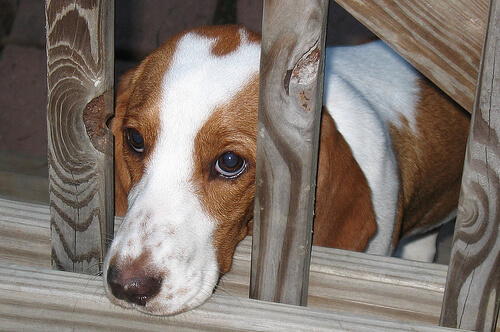6 Signs of a Scared Dog & How To Empathize

Fear is a necessary and essential emotion for survival. All mammals have the ability to feel fear. Each animal shows fear in its own way, and it’s important to understand the signs of a scared dog. This way, we can better empathize and support a dog who experiences fear.
How fear works
Fear is an emotion, just like joy, sadness or anxiety. Emotions like these are involuntary. So, we cannot simply choose whether to feel them or not. It’s just the same with our dogs – and since the fear they feel is an involuntary emotion, it makes absolutely no sense to scold a dog for feeling it. However, there are things we can do that will either increase or decrease the level of fear felt by our dogs.
When a dog is feeling scared, our actions can either help to comfort it, or can increase the fear it is feeling. However, our actions won’t reinforce the emotion itself. As we’ve said, fear is an involuntary behavior. Additionally, the ways that dogs express their fear are not voluntary. For instance, a scared dog cannot help but display the signs.

For example, if a dog is terrified of storms, it’s important to resist the temptation to scold him or her, because the behavior is not a matter of choice. It is us as the owners who have the choice – either to comfort the dog and help it through an uncomfortable time, or end up harming the dog more. Whatever we do, it is likely that when the next storm comes around, the dog will still feel fear – but if we have managed the situation badly previously, it’s likely that the dog will not come to us for consolation. It’s important to remember that the dog has no control over how he or she feels.
Fear in dogs
Dogs, like many other animals, may be afraid of many different things. Statistically speaking, it’s been shown that about half of dogs are afraid of loud noises. Of these loud noises, the most feared by dogs are storms, fireworks, and noises similar to gunfire.
A dog does not need to have gone through abuse or abandonment to feel fear. There are abandoned dogs that recover psychologically very quickly, while there are also more sensitive dogs who have never experienced abuse, but who are nevertheless afraid of any number of different stimuli.
In fact, humans, dogs and other mammals have very similar central nervous systems, the part of the body that is responsible for connecting the brain with the rest of the body. This means that dogs feel fear in much the same way as humans. So based on our own experiences of fear, we can understand and empathize with how dogs and other animals feel in similar emotional states.
Signs of fear in dogs
Every dog will try to deal with feelings of fear as best as he or she can. In the list below, you’ll find that some of the signs of fear in dogs appear contradictory – this is because there are some dogs that will display one or more of the symptoms, while others will display others. If you want to check whether your dog is afraid, check whether he or she is displaying one or more of the behaviors. However, they don’t all need to be apparent at the same time.
The most common signs of fear are:
- Panting and salivation. It’s very common for dogs to pant when they are experiencing feelings of fear – as a result, they also salivate more than usual.
- Dilated pupils. This isn’t something we are commonly used to looking out for in our dogs, but it’s been shown that dogs in a state of fear have dilated pupils.
- Trembling. Many dogs will physically shake when they feel afraid. Some start trembling at the slightest feeling of fear, while others will only do so when the feeling is extremely intense.
- Heightened movement or paralysis. In a situation that leaves them frightened, some dogs find themselves unable to stand still. Others, however, become paralyzed. Although these two signs may seem contradictory, they are two possible signs of fear in dogs.
- Tail between the legs. Perhaps the most recognizable sign of fear in dogs is that, when they find something scary, they hold their tails between their legs. However, remember that there are some breeds that have tails that can’t be lowered like this, such as Shiba Inu dogs and pugs.
- Urination and defecation, both in excess and not at all. It is common for dogs that suffer from heightened states of panic to be unable to control themselves, and urinate or defecate wherever they find themselves, including all over the house. As we said at the outset: fear is not voluntary, and you cannot choose how to behave while experiencing feelings of fear. On the other hand, other dogs are on the opposite side of the spectrum, and are unable to urinate or defecate when feeling scared.

Comfort the fear
The first thing to emphasize is that we must not punish our dogs for feeling fear. Nor should we do things that worsen the emotion. Rather, we must try to comfort our pet. And, help him or her through the situation. To understand what our dog needs when it feels like this, it’s important that we know our dog. Some dogs that prefer solitude. And, they don’t appreciate cuddling. On the other hand, some dogs seek out physical comfort from their owners. And, they won’t stop pestering until they get it.
There are also many dogs that seek physical comfort from their owners. They especially do this when they begin to feel afraid. But, this does not necessarily help them. They seek physical proximity, but find that the contact overwhelms them.
In any case, all dogs should have a safe place at home. This is a place where they can go to seek comfort. By a safe place, we mean one that is quiet and calm. And, it is easily accessible.
Finally, it is up to the owner to act as a source of calm. If you express your empathy or concern for your dog in a dramatic way, you actually won’t be doing it any favors. Instead, opt for calm body language, and a confident and relaxed tone of voice. This will help any dog that’s experiencing fear to make it through.